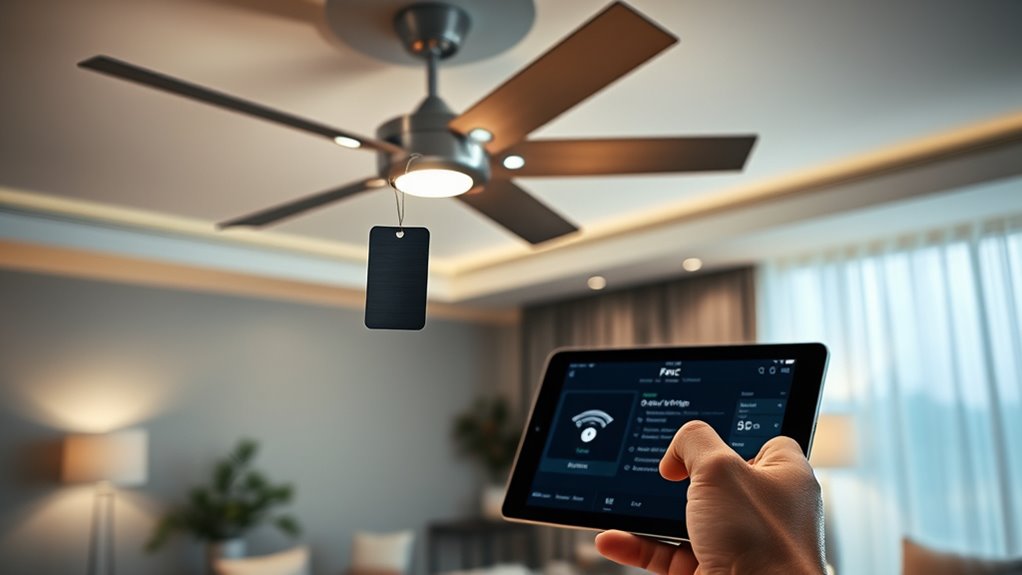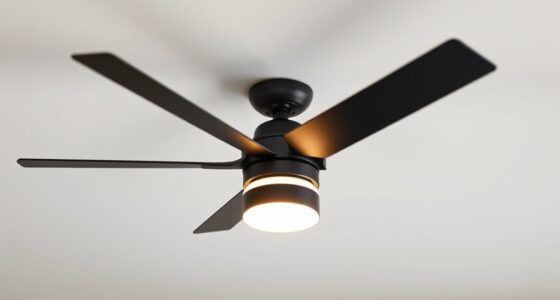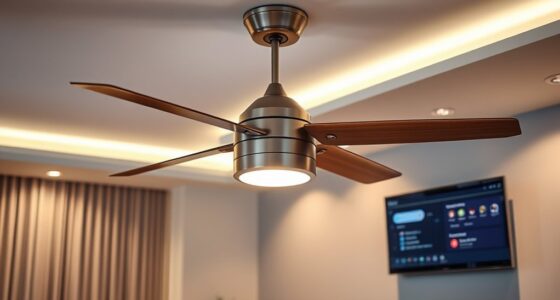Using NFC tags to trigger fan settings instantly is simple and effective. You program the tags with specific commands for your fan, such as turning it on, changing speed, or switching modes. Then, you place the tags at convenient spots like doorways or near your bed. Just tap your phone against the tag, and your fan responds automatically. To explore how to choose, program, and position these tags for smooth operation, keep exploring further.
Key Takeaways
- Program NFC tags with specific fan commands using trusted NFC writing apps for quick, instant activation.
- Mount tags at accessible, strategic locations like entry points or near fans for immediate control.
- Ensure tags are durable and weatherproof if placed outdoors or in humid environments to maintain functionality.
- Test each NFC tag after programming to confirm it triggers the intended fan settings correctly.
- Integrate NFC tags with compatible smart home platforms for seamless, automated control and synchronization.
Understanding NFC Technology and Its Capabilities

NFC, or Near Field Communication, is a short-range wireless technology that allows devices to exchange data quickly and securely when they’re brought close together. Its capabilities include simple, contactless data transfer, making it ideal for triggering smart home devices like fans. When exploring NFC, you’ll want to take into account NFC security, which ensures your data stays protected during exchanges. Modern NFC systems use encryption to prevent unauthorized access. Compatibility is also key; NFC hardware compatibility varies across devices. Most smartphones and NFC tags support standard protocols, but it’s essential to ensure your device can read and write NFC tags effectively. Understanding these aspects helps you set up a safe, reliable NFC system for automating fan controls with confidence.
Selecting the Right NFC Tags for Your Fan Setup
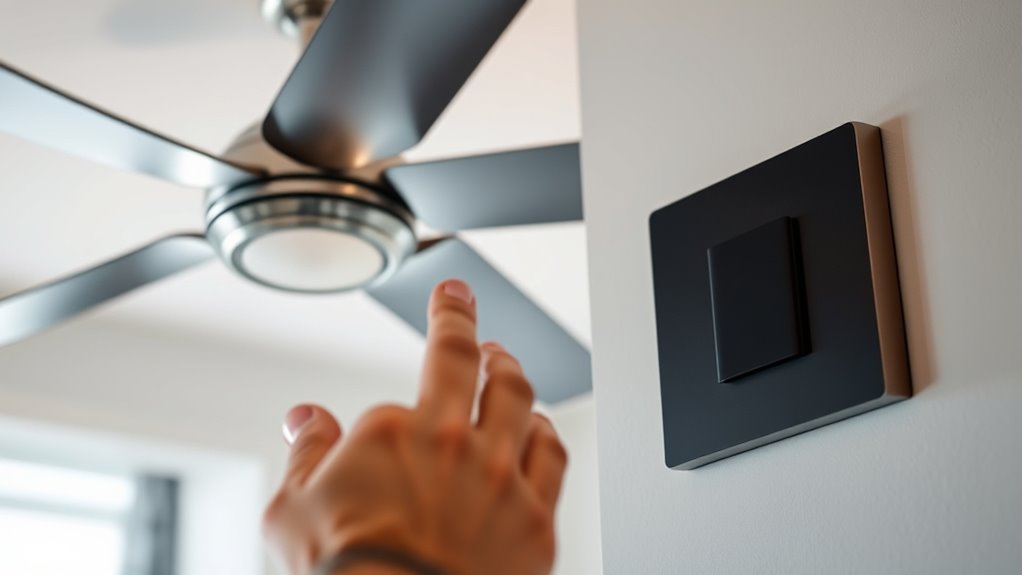
Choosing the right NFC tags is essential for guaranteeing your fan automation works smoothly. You want tags that are durable enough to withstand daily use and match your aesthetic style. Consider the following:
- Material durability: Opt for tags made from sturdy materials like plastic or metal to prevent wear and tear. Additionally, selecting tags that can resist environmental factors such as moisture or heat can extend their lifespan, especially in diverse settings. Environmental resistance is crucial for outdoor or humid environments.
- Aesthetic design: Choose tags that blend seamlessly with your decor, whether sleek and modern or rustic. Matching the style of your NFC tags to your environment enhances the overall look.
- Size and placement: Select small, unobtrusive tags that fit well in your intended spot. Proper placement ensures easy access without disrupting the visual harmony of your space.
- Compatibility: Ensure the tags are compatible with your device’s NFC frequency and read range. This guarantees reliable communication between your device and the tags.
- Proper integration: Using tags with the appropriate water resistance and durability can ensure long-term functionality in various environments. Being aware of the environmental conditions where the tags will be used helps in choosing the most suitable option for longevity and performance.
Programming NFC Tags to Control Fan Settings
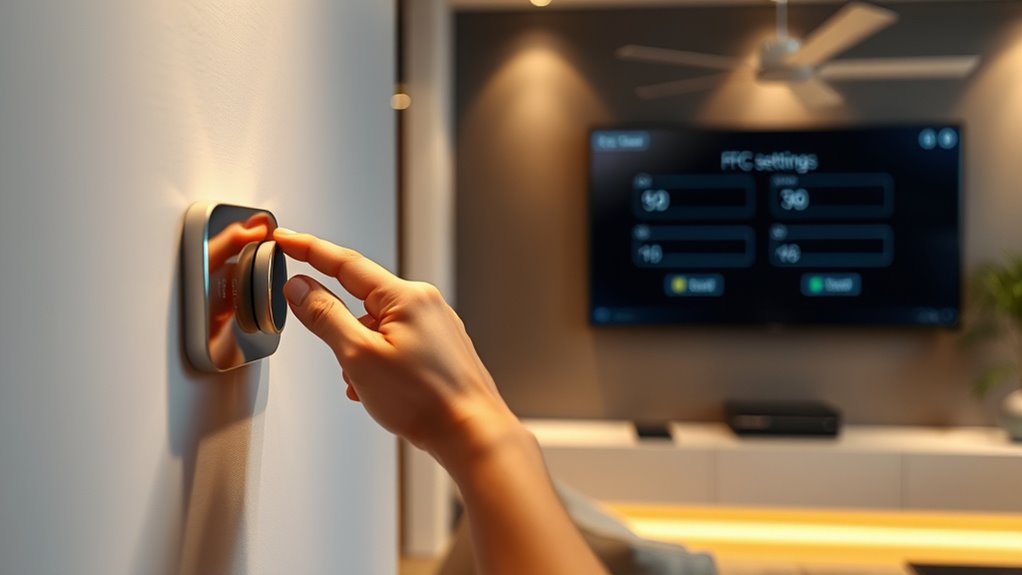
Programming your NFC tags to control fan settings is straightforward once you understand the steps involved. You’ll need to set up specific commands that match your desired fan configurations, making adjustments easy and quick. By customizing these commands, you guarantee your NFC tags trigger exactly what you want every time. For enthusiasts interested in vehicle customization, Kia Tuning offers a variety of modifications to optimize performance and aesthetics. Additionally, understanding smart device integration can further enhance your control options. Recognizing how lifestyle trends influence smart home device usage can help you create a more intuitive and personalized environment.
NFC Tag Programming Steps
To set up your NFC tags for controlling fan settings, start by selecting a compatible NFC tag and ensuring your smartphone or device has the necessary NFC reading and writing capabilities. Before programming, consider NFC data encryption to protect your commands from unauthorized access. Also, choose NFC tags with high durability to withstand frequent use. Incorporating popular juice brands in your device setup can provide insights into trusted and reliable products that ensure consistent performance. To program your NFC tag:
- Use a trusted NFC writing app on your device.
- Enter the specific fan control command or URL.
- Write the data to the NFC tag, ensuring the process completes successfully.
- Test the tag to confirm it triggers the desired fan settings.
- Remember to review your privacy policy to understand how your data is managed during this process.
- Additionally, check that your device’s NFC hardware supports Bluetooth pairing for seamless integration with various smart devices.
Customizing Fan Commands
Once you’ve selected and programmed your NFC tags, customizing the commands allows you to control your fan settings precisely. You can set specific instructions for different scenarios, such as adjusting speed, turning the fan on or off, or activating energy-saving modes. By tailoring commands, you optimize fan performance and simplify maintenance routines, making fan maintenance easier and faster. Custom commands can help improve energy efficiency by automatically reducing power usage during low-traffic periods or when the room is unoccupied. This level of control ensures your fan operates at peak efficiency, saving you money and reducing your environmental impact. Additionally, integrating automated control with NFC tags provides a seamless experience, allowing you to manage multiple aspects of your fan with just a tap, which is especially beneficial in busy or smart home environments. Understanding projector technology can further enhance your setup by ensuring optimal compatibility and performance, leading to a more integrated and efficient home environment. With personalized NFC commands, you gain seamless, instant control over your fan’s behavior, enhancing overall comfort and operational effectiveness.
Integrating NFC Tags With Smart Fans and Home Automation Systems

To get the most out of your NFC tags, you need to ensure where to place them for easy access and reliable triggers. You’ll also want to consider your smart fan and home automation platform are compatible and can communicate seamlessly. Finally, customizing the trigger actions allows you to tailor your fan settings perfectly to your routines and preferences.
NFC Tag Placement Strategies
Strategically placing NFC tags is essential for seamless integration with smart fans and home automation systems. You want your tags accessible yet protected, ensuring reliable triggers and maintaining security. Consider these placement tips:
- Position tags near entry points for quick access.
- Mount them at eye level for ease of use.
- Avoid humid or dusty areas to preserve tag durability.
- Hide tags behind furniture or décor to prevent tampering.
- Use durable materials for NFC tags to withstand environmental conditions and ensure longevity. Selecting the right environmental resistance helps maintain functionality over time.
- Additionally, choosing tags with weatherproof design can further enhance their durability in various settings.
Prioritize NFC security by choosing durable tags that resist wear and environmental damage. Proper placement guarantees consistent performance and reduces the risk of accidental scans. Remember, well-placed tags not only improve convenience but also help maintain the integrity of your automation setup. By following these strategies, you’ll ensure your NFC system remains reliable and secure for everyday use.
Compatible Home Automation Platforms
Choosing the right home automation platform is key to seamlessly integrating NFC tags with your smart fans. Platforms like SmartThings, Home Assistant, and Apple HomeKit support NFC triggers, making setup straightforward. These systems can connect your NFC tags to voice control features, so you can activate fan settings with a simple command. They also optimize energy efficiency by adjusting fan speeds based on your activity. Additionally, understanding meditation can help you create a calm environment that enhances your smart home experience. Incorporating automated control systems can further streamline your home management and improve efficiency. Here’s a quick comparison:
| Platform | Compatibility & Features |
|---|---|
| SmartThings | Wide device support, easy NFC integration |
| Home Assistant | Customizable, supports automations |
| Apple HomeKit | Seamless Apple ecosystem integration, voice control |
Choosing a platform tailored to your needs guarantees smooth NFC integration and smarter, energy-efficient fan control. Incorporating smart home automation principles can further enhance your environment by creating intuitive and personalized experiences.
Customizing Fan Trigger Actions
Integrating NFC tags with your smart fan system allows you to customize trigger actions that match your specific preferences. You can set different fan behaviors based on the NFC tag you scan, whether it’s on your wearable device or a household item. With cloud connectivity, these actions can be stored and accessed remotely, making adjustments effortless. For example, you might program an NFC tag on your bedside table to turn on the fan and adjust speed when you arrive home. You can also link NFC tags to:
- Activate different fan modes for morning, night, or workout routines
- Sync with wearable devices to trigger specific settings based on activity
- Use cloud connectivity to update trigger actions remotely
- Integrate with smart home systems for seamless automation
This customization enhances comfort and convenience. Proper installation and placement are key to ensuring reliable operation and safety. Additionally, understanding smart home integration allows for more comprehensive automation, making your environment even more tailored to your needs. Incorporating space management strategies can help in organizing your smart devices efficiently and ensuring smooth operation.
Practical Use Cases for NFC-Triggered Fan Adjustments
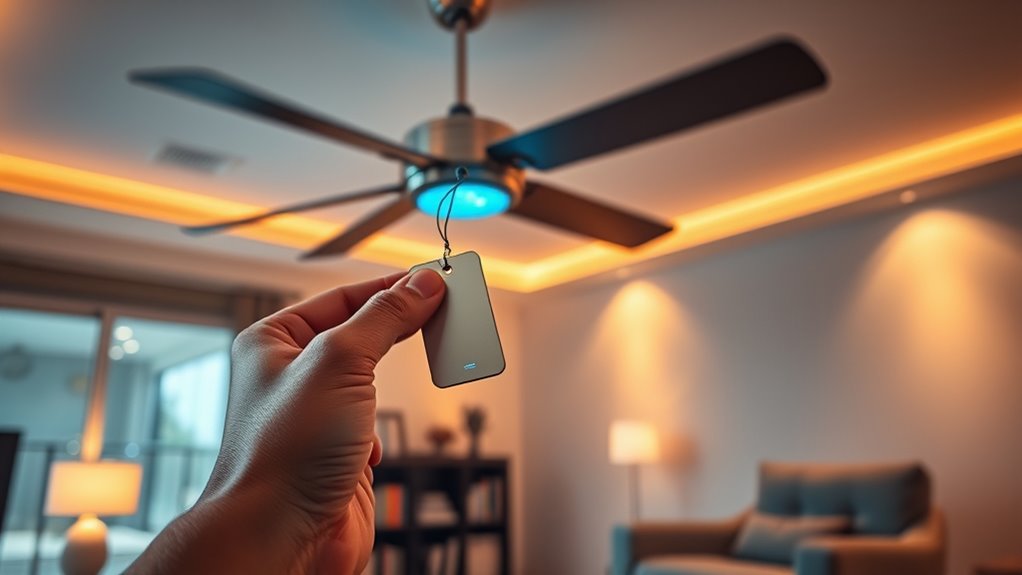
NFC tags offer a quick and convenient way to customize fan settings for various situations. For DIY projects, you can set up NFC tags near your workspace or living area to instantly adjust fans to ideal airflow, improving comfort and energy efficiency. They’re also handy in shared spaces, allowing family members or roommates to personalize their environment with a simple scan. When implementing NFC-triggered fan adjustments, security considerations are important—avoid placing tags in easily accessible locations to prevent unauthorized changes. You might also program tags to activate specific fan modes for different times of day or activities, like quiet sleep mode or high-power cooling. These practical use cases make managing fan settings effortless, saving time and ensuring comfort in everyday life.
Tips for Placing and Using NFC Tags Effectively
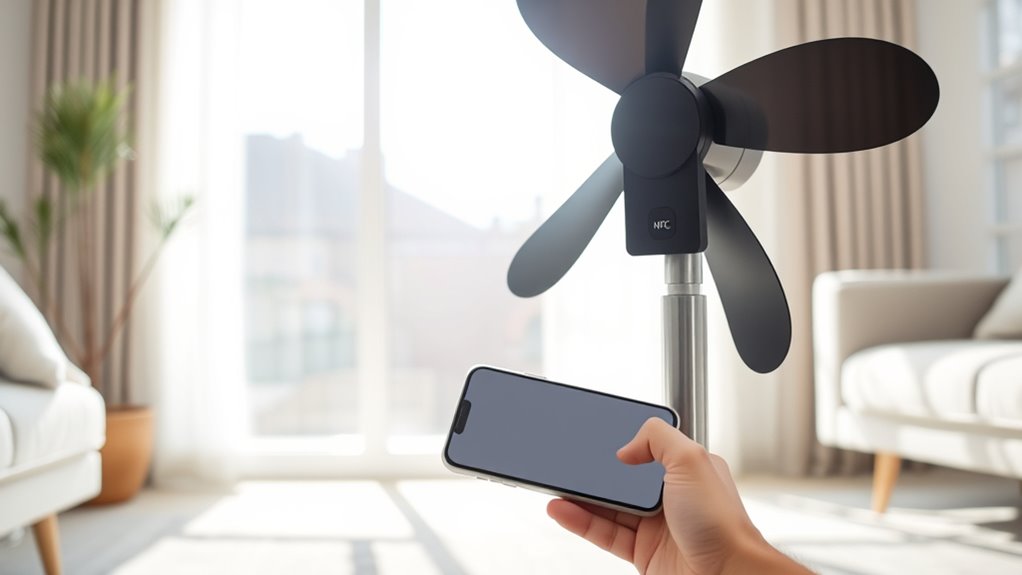
To guarantee your NFC tags work effectively, carefully consider their placement so they’re both accessible and secure. Position tags where you naturally interact, avoiding areas prone to moisture or accidental damage. Ensuring good NFC security means keeping tags out of reach of tampering or theft. Also, prioritize tag durability by choosing weatherproof or rugged options suited for your environment.
Place NFC tags at accessible, secure spots away from moisture and damage for optimal performance.
Here are tips for ideal placement:
- Mount tags at eye level for easy access
- Avoid locations with high magnetic interference
- Use protective enclosures to prevent physical damage
- Secure tags firmly to prevent accidental removal
Troubleshooting Common Issues With Nfc-Enabled Fan Controls

Even with careful placement, you might encounter issues with your NFC-enabled fan controls. Security concerns can arise if your NFC tags aren’t properly protected, risking unauthorized access or changes. Make sure your system uses secure encryption to prevent hacking. Battery life can also be a problem; if your NFC tags or sensors run low, they won’t respond reliably. Regularly check and replace batteries or recharge batteries in NFC-enabled devices to maintain functionality. If your fan isn’t responding, verify the NFC tag’s placement, ensure it’s within range, and confirm your device’s compatibility. Updating firmware and resetting the NFC tags might also resolve connectivity issues. Addressing these common problems helps ensure your NFC-controlled fan operates smoothly and securely.
Frequently Asked Questions
Can NFC Tags Be Reused for Different Fan Settings?
You can reuse NFC tags for different fan settings through tag customization, but there are reuse limitations to contemplate. While some tags can be reprogrammed multiple times, others may lose functionality over time. If you want to change fan settings frequently, choose programmable tags that support multiple rewrites. Keep in mind, reusing tags may require reconfiguration and testing to ensure they trigger the correct settings each time.
What Are the Security Considerations When Using NFC Tags?
When considering security with NFC tags, you should focus on data encryption and user authentication. Guarantee the tags use encryption to protect sensitive information from eavesdropping or tampering. Implement user authentication to verify identities before accessing or modifying settings. Be aware that NFC tags can be cloned or hacked if not properly secured. Regularly update security protocols and limit access to trusted users to keep your system safe.
How Do NFC Tags Affect Fan Energy Efficiency?
NFC tags can improve fan energy efficiency by enabling quick adjustments to settings, which promotes energy savings. You’ll appreciate the user convenience of instantly customizing fan speed or turning it off when not needed. By effortlessly managing your fan with a tap, you reduce unnecessary energy use, helping to lower electricity bills and minimize environmental impact. This seamless control makes your space more energy-efficient and user-friendly.
Are NFC Tags Compatible With All Smart Fan Brands?
Think of NFC compatibility like a universal translator for smart fans. Not all fan brands play by the same rules, so integration depends on the manufacturer’s tech. Some brands support NFC tags seamlessly, while others might need extra gadgets or apps. Before you buy, check if your fan’s brand supports NFC or offers compatible integration options. This way, you’ll guarantee smooth communication between your NFC tags and your smart fan.
What Is the Typical Cost for Implementing Nfc-Based Controls?
The typical cost for implementing NFC-based controls varies depending on your setup. You should do a cost analysis to compare NFC tags, readers, and integration costs against your budget. Keep in mind, implementation challenges like compatibility issues or tech adjustments can add to expenses. Generally, expect to spend between $50 to $200 per fan for a complete NFC control setup, but costs can fluctuate based on complexity.
Conclusion
By using NFC tags to control your fans, you instantly customize comfort with a simple tap. Did you know that NFC technology is present in over 2 billion devices worldwide? This widespread adoption makes it easy to integrate NFC into your home for seamless automation. With quick setup and versatile placement, you can enjoy personalized airflow anytime, boosting convenience and energy efficiency. Embrace NFC, and transform your fan experience effortlessly.
